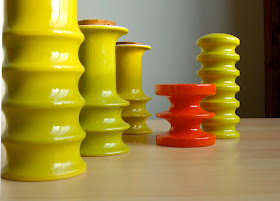Something to add a bit of warmth to a winter day.
There are Dancing flames, fire-red colours and bubbling lava flows on these vintage West German vases.
I have an idea they are all by Scheurich and they probably date from the 1960s or 1970s. Grouped together, they certainly help to warm up a retro-styled interior.
There seems a lot more information available on West German pottery these days - and some very keen collectors. There are some amazing images and lots of good info on one of my favourite blogs, here: Blurat West German pottery



















































